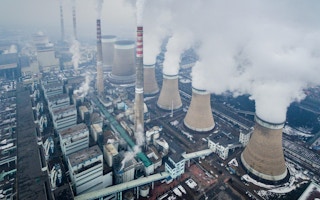In a major development in the run-up to the COP26 climate negotiations in Glasgow in November, China has pledged to stop financing coal-fired power stations overseas.
To continue reading, subscribe to Eco‑Business.
There's something for everyone. We offer a range of subscription plans.
- Access our stories and receive our Insights Weekly newsletter with the free EB Member plan.
- Unlock unlimited access to our content and archive with EB Circle.
- Publish your content with EB Premium.
The world’s largest emitter of greenhouse gas, China is also the biggest funder of new coal projects.
“China will step up support for other developing countries in developing green and low carbon energy, and will not build new coal-fired power projects abroad,” China President Xi Jinping said in a pre-recorded speech to the United Nations General Assembly on Tuesday.
He gave no further details or a timeline for the withdrawal from coal, which is the single biggest contributor to man-made greenhouse gas emissions. He stopped short of committing to phasing out coal domestically. Coal represents nearly 60 per cent of the country’s electricity mix.
COP26 president Alok Sharma welcomed the news, announcing on Twitter “it is clear the writing is on the wall for coal power.”
COP26 has been earmarked by Sharma as “the COP that consigns coal to history”. Sharma said that keeping global temperatures from rising by more than 1.5°C above pre-industrialised levels would be “extremely difficult” without a commitment from countries to phase out coal.
China has funded 63 per cent of global publicly financed coal projects since 2013, principally in developing countries including Indonesia, Vietnam, Pakistan, South Africa, India and Bangladesh, and has more than 40 gigawatts (GW) of coal in 20 countries in the pre-construction pipeline.
Leo Roberts, research manager, coal diplomacy, for European thinktank E3G, said Xi’s policy shift will “have a dramatic positive impact on Asian and global aspirations to move away from coal and keep 1.5°C on track.”
The 1.5°C global warming ceiling, as stipulated in the 2015 climate accord in Paris, will need to be maintained to avoid the most dire consequences of climate change. In May, The International Energy Agency said no new coal facilities should be developed if the world is to reach net zero by 2050.
An Intergovernmental Panel on Climate Change report, released in August, revealed that the world is well off-track from curbing warming to 1.5°C, and dramatic interventions — including no more coal-fired power stations — would be needed to avoid climate calamity, which will be most severely felt in poorer countries.
“This is a major step forward,” Manish Bapna, president of the Natural Resources Defense Council, said in a statement. “This opens the door to bolder climate ambition from China and other key countries, at home and abroad, ahead of the global climate talks in Glasgow.”
Chuck Baclagon, 350.org’s Asia finance campaigner, said that Chinese institutions have “a track record of overachieving once there is high level commitment to a target”, and he hoped the pledge would similarly be seen through.
Chinese investments in overseas coal have been dropping quickly in recent years. In 2020, China’s investment in renewables in countries that are part of its Belt and Road infrastructure strategy exceeded those in fossil fuels projects for the first time.
In the first half of this year, China did not finance any coal projects, including coal power and coal mining, in Belt and Road countries, according to American Enterprise Institute data.
But China remains reliant on coal domestically. China’s provincial governments approved the construction of 24 new coal power projects in the first half of 2021, according to Greenpeace research.
“If coal capacity remains option number one to secure energy supply, and provinces see that securing energy ranks as a national interest, then that’s a clear pipeline to continue building coal. Reliance on coal is turning energy security and economy into sources of inertia, not development,” Li Danqing, a Beijing-based project leader for Greenpeace East Asia said at the time.
China’s biggest lenders of the past decade include Export Import Bank of China (US$14 billion), China Development Bank (US$10 billion), Industrial and Commercial Bank of China (US$6 billion) and Bank of China (US$3.5 billion), according to data from Market Forces.
Xi’s declaration follows similar announcements made by two other major Asian overseas coal backers, Japan, made in March, and Korea, in July.










